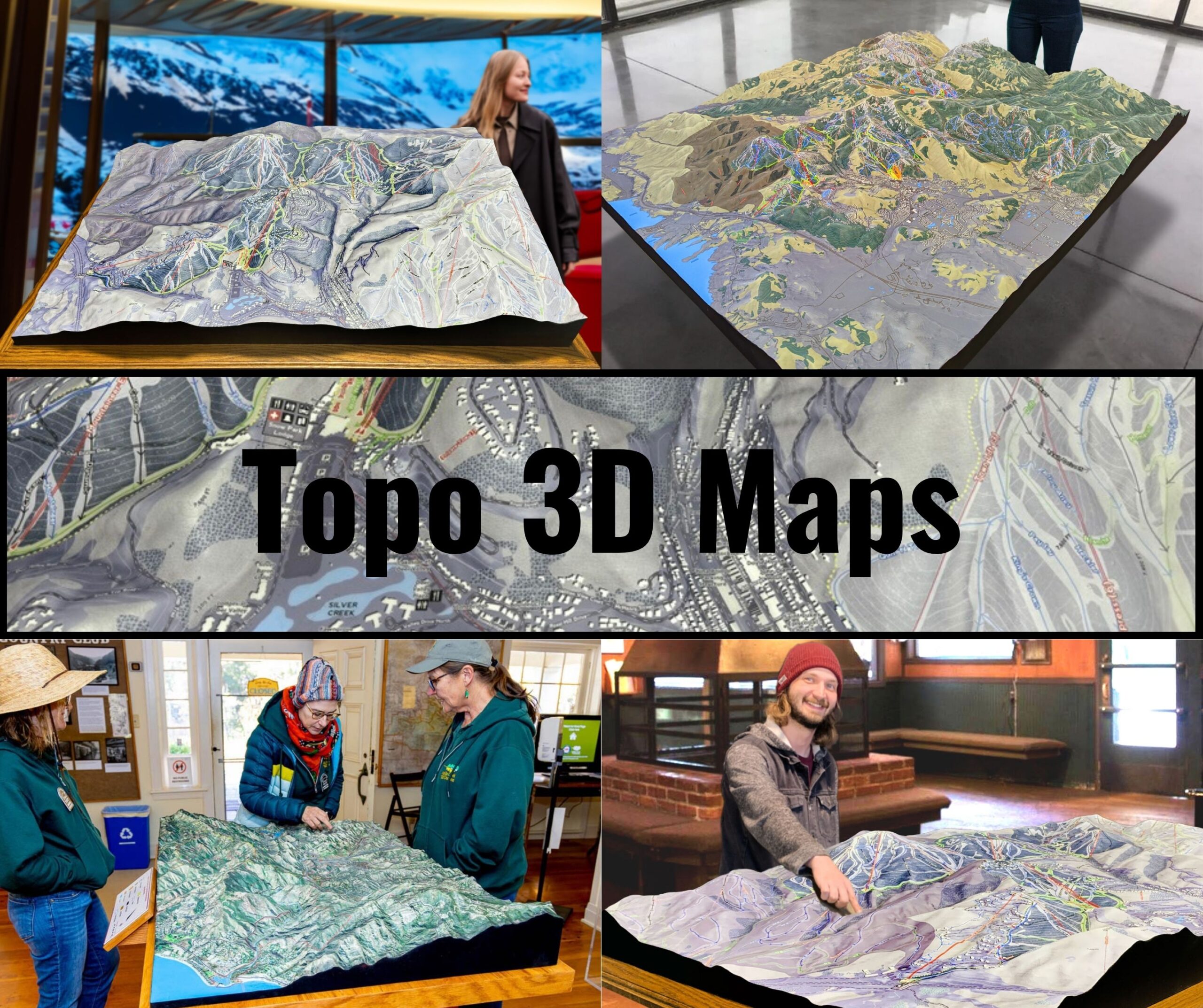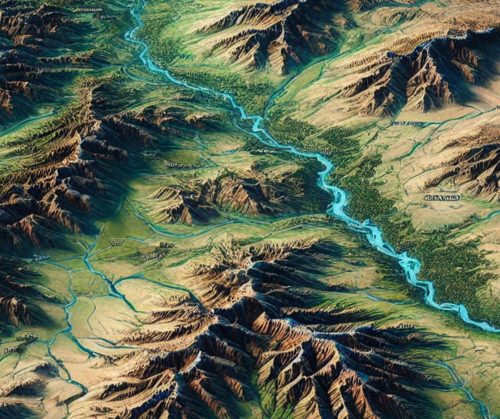New Mexico Topo Map
New Mexico Topo Map
We Build Custom 3D Topo Maps
New Mexico Topo Maps: Exploring the Land of Enchantment’s Diverse Terrain
New Mexico, aptly named the Land of Enchantment, is a state of striking contrasts and breathtaking landscapes. From the rugged peaks of the Sangre de Cristo Mountains to the vast, arid expanses of the Chihuahuan Desert, and from ancient volcanic fields to dramatic river valleys, New Mexico offers a blend of geological wonders and natural beauty. Topographic maps are essential for navigating and understanding this diverse terrain, revealing every contour, elevation, and natural feature that defines the state.
New Mexico’s topographic maps, available in both 2D and 3D formats, provide invaluable insights for adventurers, conservationists, geologists, and educators. These maps illuminate the state’s geographic diversity, offering a deeper appreciation for its stunning landscapes.

The Sangre de Cristo and Southern Rocky Mountains: Peaks and High Valleys
The Sangre de Cristo Mountains, part of the Southern Rocky Mountains, dominate northern New Mexico with their towering peaks, alpine forests, and high desert valleys. This region includes some of the state’s highest elevations, such as Wheeler Peak at 13,167 feet.
In 2D topographic maps, the Sangre de Cristo Mountains are depicted with tightly packed contour lines that highlight their steep slopes and sharp ridges. Features such as ski areas, hiking trails, and high-altitude lakes are prominently marked, making these maps invaluable for outdoor enthusiasts and conservationists.
3D topographic maps bring the Sangre de Cristo Mountains to life, showcasing the dramatic elevation changes and the interplay of peaks, valleys, and forested slopes. These maps are essential for mountaineers, geologists, and researchers studying the region’s unique ecosystems.
The Chihuahuan Desert: Vast Plains and Hidden Canyons
The Chihuahuan Desert, extending into southern New Mexico, is a sprawling expanse of arid plains, rugged hills, and hidden canyons. This region is home to iconic landscapes such as White Sands National Park and Carlsbad Caverns National Park.
In 2D topographic maps, the Chihuahuan Desert is represented with contour lines that detail its flat plains and subtle elevation changes. Features such as sand dunes, desert springs, and deep canyons are clearly marked, providing valuable insights for navigation and ecological studies.
3D topographic maps of the Chihuahuan Desert emphasize the vastness of its plains, the undulating terrain of its dunes, and the depth of its canyons. These maps are indispensable for conservationists, desert explorers, and scientists studying this unique arid ecosystem.
The Rio Grande Valley: Lifeline Through the Desert
The Rio Grande, one of North America’s longest rivers, flows through New Mexico, carving a dramatic valley that supports agriculture, wildlife, and human settlements. This river is a critical feature of the state’s geography and history.
In 2D topographic maps, the Rio Grande Valley is depicted with contour lines that illustrate the elevation changes along its banks and surrounding mesas. Features such as reservoirs, irrigation canals, and urban areas like Albuquerque are prominently displayed.
3D topographic maps of the Rio Grande Valley provide a more immersive view, highlighting the depth of the river channel, the height of surrounding bluffs, and the interplay of natural and human-altered landscapes. These maps are essential for water resource managers, ecologists, and outdoor enthusiasts.
Volcanic Landscapes: Ancient Lava Fields and Cinder Cones
New Mexico’s volcanic history is evident in its dramatic landscapes of ancient lava fields, cinder cones, and dormant volcanoes. Sites such as the Valley of Fires and the Capulin Volcano National Monument showcase this geological legacy.
In 2D topographic maps, volcanic features are represented with contour lines that detail the slopes of cinder cones, the extent of lava flows, and the rugged terrain of volcanic fields. These maps provide critical information for geologists and adventurers exploring these unique areas.
3D topographic maps of volcanic landscapes emphasize the dramatic elevation changes of cinder cones, the undulating patterns of lava fields, and the surrounding high desert terrain. These maps are invaluable for understanding and appreciating New Mexico’s volcanic past.
The Colorado Plateau: Mesas, Canyons, and Cultural Heritage
The northwestern part of New Mexico is part of the Colorado Plateau, a region of mesas, canyons, and colorful rock formations. This area is rich in Native American history and includes landmarks like Chaco Canyon and Shiprock.
In 2D topographic maps, the Colorado Plateau is depicted with contour lines that illustrate the elevation changes of its mesas, the depth of its canyons, and the expanse of its high desert plains. Features such as archaeological sites and hiking trails are prominently displayed.
3D topographic maps bring the Colorado Plateau to life, showcasing the dramatic cliffs, the intricate patterns of canyons, and the isolated grandeur of Shiprock. These maps are essential for archaeologists, conservationists, and adventurers exploring this culturally and geologically significant region.
New Mexico’s Forested Regions: Biodiversity in the Mountains
In addition to its arid deserts and rugged peaks, New Mexico is home to forested regions such as the Gila National Forest and Lincoln National Forest. These areas offer lush biodiversity and a stark contrast to the surrounding deserts.
In 2D topographic maps, forested regions are depicted with contour lines that highlight the elevation changes of their mountains and valleys. Features such as rivers, trails, and campgrounds are clearly marked, providing critical guidance for outdoor recreation and conservation.
3D topographic maps emphasize the dense forests, the depth of mountain valleys, and the rugged terrain of these regions. These maps are invaluable for hikers, ecologists, and researchers studying New Mexico’s forested landscapes.
How New Mexico Topo Maps Are Fabricated: Precision and Craftsmanship in 2D and 3D
Creating topographic maps of New Mexico requires advanced technology, meticulous data collection, and skilled craftsmanship. From the towering peaks of the Sangre de Cristo Mountains to the arid expanses of the Chihuahuan Desert, New Mexico’s diverse terrain demands accurate and detailed mapping.
For 2D topographic maps, the process begins with data collection from sources such as satellite imagery, aerial surveys, and LiDAR (Light Detection and Ranging). This data is processed using Geographic Information Systems (GIS) software to create contour lines that represent changes in elevation. In New Mexico, special attention is given to capturing the steep slopes of the Rockies, the subtle terrain of the deserts, and the intricate river systems. Additional features such as trails, roads, and cultural landmarks are added to create a comprehensive map.
Creating 3D topographic maps involves rendering elevation data into three-dimensional models. Advanced software translates the data into digital 3D representations, which can then be printed using 3D printers or displayed digitally for interactive exploration. For New Mexico, particular care is taken to highlight features such as the alpine zones of the Sangre de Cristo Mountains, the vast plains of the Chihuahuan Desert, and the dramatic mesas of the Colorado Plateau.
Once the 3D maps are created, they are often painted and finished to enhance their visual appeal and highlight key features such as elevation changes, vegetation, and water bodies. These maps provide a tactile and immersive way to explore New Mexico’s landscapes, making them invaluable for educators, researchers, and outdoor enthusiasts.
New Mexico Topo Maps for Conservation, Adventure, and Education
Topographic maps play a crucial role in conserving New Mexico’s natural resources, supporting outdoor recreation, and educating people about the state’s geography. With its diverse ecosystems and rich cultural heritage, New Mexico requires careful management to preserve its environment and history.
Conservationists use topographic maps to monitor changes in New Mexico’s environment, plan restoration projects, and protect critical habitats. For example, in the Rio Grande Valley, these maps guide efforts to manage water resources and restore wetlands. In the volcanic regions, topographic maps help preserve unique geological features.
For adventurers, topographic maps are essential tools for exploring New Mexico’s trails, deserts, and mountains. Hikers rely on these maps to navigate the Wheeler Peak Wilderness or the Gila National Forest, while paddlers use them to plan routes along the Rio Grande.
Conclusion: New Mexico’s Landscapes Through the Lens of Topographic Maps
New Mexico’s topographic maps reveal the state’s diverse and enchanting landscapes in stunning detail. From the towering peaks of the Sangre de Cristo Mountains to the arid plains of the Chihuahuan Desert, the dramatic Rio Grande Valley, and the culturally rich Colorado Plateau, these maps capture the beauty and complexity of the Land of Enchantment.
Whether you’re an adventurer exploring New Mexico’s natural wonders, a scientist studying its ecosystems, or an educator teaching geography, topographic maps provide an invaluable tool for understanding and appreciating the state’s terrain. With both 2D and 3D options available, these maps ensure that future generations can continue to explore, protect, and enjoy the landscapes that make New Mexico unique.
Check out WhiteClouds’ 3D Maps for more information on New Mexico topo maps.
